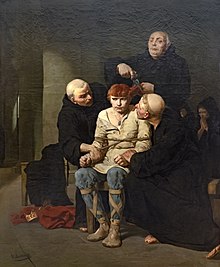| Childeric III | |
|---|---|
 Childeric III, 18th-century medallion by Jean Dassier | |
| King of the Franks | |
| Reign | 743–751 |
| Predecessor | Theuderic IV |
| Successor | Pepin the Short |
| Born | c. 717 |
| Died | c. 754 |
| Issue | Theuderic |
| Dynasty | Merovingian |
| Father | Chilperic II or Theuderic IV[1] |
Childeric III (c. 717 – c. 754) was King of the Franks from 743 until he was deposed in 751 by Pepin the Short. He was the last Frankish king from the Merovingian dynasty. Once Childeric was deposed, Pepin became king, initiating the Carolingian dynasty.[2]
Following the reign of Dagobert I (629–634), the power of the Merovingian kings gradually declined into a ceremonial role, while the real power in the Frankish kingdom was increasingly wielded by the mayors of the palace. In 718, Charles Martel combined the roles of mayor of the palace of Neustria and mayor of the palace of Austrasia, consolidating his position as the most powerful man in Francia. After the death of king Theuderic IV in 737, Charles Martel ruled without a king on the throne.
After Charles Martel's death in 741, Carloman and Pepin the Short, his sons by his first wife Rotrude, became co-mayors of the palace. However, they soon faced revolts from their younger half-brother Grifo and their brother-in-law Odilo, Duke of Bavaria. These revolts may have played a part in their decision to fill the throne with a Merovingian king after a six-year vacancy to add legitimacy to their reigns.[3]

Childeric's parentage and his relation to the Merovingian family are uncertain. He may have been either the son of Chilperic II or Theuderic IV.[1]
According to Einhard, Charlemagne's biographer, Childeric took little part in public business and would, once a year, be brought in an ox cart led by a peasant and preside at court on a throne, giving answers prepared by the mayors to visiting ambassadors.[4] In this narrative, he had neither political nor economic power, depending on his own small estate and on mayoral support.[4]
After Carloman retired to a monastery in 747, Pepin resolved to take the royal crown for himself. Pepin sent letters to Pope Zachary, asking whether the title of king belonged to the one who had exercised the power or the one with the royal lineage. The pope responded that the real power should have the royal title as well. In 751, Childeric was dethroned and tonsured.[5] His long hair was the symbol of his dynasty, and thus of the royal powers he enjoyed; by cutting it, they divested him of all royal prerogatives. Once dethroned, he was confined to the Benedictine monastery of Saint-Bertin[6] in Saint-Omer, while his son Theuderic was sent to the monastery of Saint-Wandrille.
There are conflicting accounts of exactly when Childeric died, with some sources claiming as early as 753, while others state that his death occurred as late as 758.